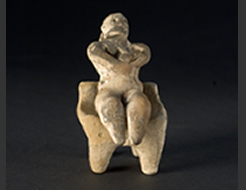|
||||||||||||||||||||||||||||||||
|
|
Museum of: Berlin | |||||||||||||||||||||||||||||||
| Name of the artefact: Female figurine | ||||||||||||||||||||||||||||||||
|
Illustrations of mother deities as a symbol for
fertility were widespread in Europe during the Upper Paleolithic und
Neolithic periods. |
||||||||||||||||||||||||||||||||
|
WHERE IS IT AND MAIN CHARACTERISTICS |
STATE |
|||||||||||||||||||||||||||||||
|
Department: |
Museum for Pre- and Early History |
Preservation: |
Good | |||||||||||||||||||||||||||||
|
Inventory number: |
VIIIa 193a-b |
Restauration: |
No restored | |||||||||||||||||||||||||||||
|
Name of the artefact: |
Female figurine |
Completeness: |
Complete | |||||||||||||||||||||||||||||
|
Object type: |
Human figurine |
|||||||||||||||||||||||||||||||
|
Material: |
Clay |
|||||||||||||||||||||||||||||||
|
Methof of manufacture: |
Pottery, formed by hand |
|||||||||||||||||||||||||||||||
|
Decoration type: |
No decoration |
|||||||||||||||||||||||||||||||
|
Distinctive mark: |
Figurine sitting on a throne |
|||||||||||||||||||||||||||||||
|
DIMENSIONS |
PERIOD OF USE |
|||||||||||||||||||||||||||||||
|
Length (mm): |
woman 110 |
Epoque: |
Neolithic |
|||||||||||||||||||||||||||||
|
Heigth
(mm): |
woman on the throne 60 |
Culture: |
Cucuteni culture |
|||||||||||||||||||||||||||||
|
Diameter
(mm): |
- |
Period: |
Upper Neolithic |
|||||||||||||||||||||||||||||
|
Width (mm): |
throne 48-53 |
Face: |
- |
|||||||||||||||||||||||||||||
|
Thickness (mm): |
- |
Absolute chronology: |
4th mil. BC |
|||||||||||||||||||||||||||||
|
Weight
(g): |
112 |
|||||||||||||||||||||||||||||||
DISCOVERY |
||||||||||||||||||||||||||||||||
|
Date: |
Bought by the museum in 1917 |
Country: |
Romania |
|||||||||||||||||||||||||||||
|
District: |
Unknown |
Town hall affiliation: |
Unknown |
|||||||||||||||||||||||||||||
|
Village: |
Unknown |
Discovery findspot: |
Unknown |
|||||||||||||||||||||||||||||
|
Condition of discovery: |
Unknown |
Discovery type: |
Other |
|||||||||||||||||||||||||||||
|
ANALYSES – DETERMINATIONS |
FILLED IN BY |
|||||||||||||||||||||||||||||||
|
Type: |
- |
Name: |
Dr. Manfred Nawroth |
|||||||||||||||||||||||||||||
|
Laboratory: |
- |
Institution: |
Museum for Pre- and Early History |
|||||||||||||||||||||||||||||
|
No./Code: |
- |
Date: |
11/11/2005 |
|||||||||||||||||||||||||||||
|
DEEPENINGS |
||||||||||||||||||||||||||||||||
|
Morphology of the object: |
||||||||||||||||||||||||||||||||
|
The object consists of two separated pieces, a woman
and a throne. Both are damaged on the surface. The female figurine was
broken into three pieces and restored. The longhaired woman holds a
little child in her arms in front oh her breasts. At the end of the legs
there are no feet shown. The throne has a quadratic seat standing on
four chair legs. |
||||||||||||||||||||||||||||||||
|
Decoration: |
||||||||||||||||||||||||||||||||
|
- |
||||||||||||||||||||||||||||||||
|
Inscription: |
||||||||||||||||||||||||||||||||
|
- |
||||||||||||||||||||||||||||||||
|
Analogies: |
||||||||||||||||||||||||||||||||
|
Female figurines were widespread from the Middle East
to the Mediterranean area and Central Europe in the Neolithic. In South
East Europe numerous female figurines were discovered, mostly belonging
to the Cucuteni culture. Several were found around a settlement of
Cucuteni which was built on a mountain plateau in East Rumania. |
||||||||||||||||||||||||||||||||
|
Interpretation: |
||||||||||||||||||||||||||||||||
|
Illustrations of mother deities as a symbol for
fertility were well known in the Upper Paleolithic and Neolithic periods.
|
||||||||||||||||||||||||||||||||
|
Bibliography: |
||||||||||||||||||||||||||||||||
|
- |
||||||||||||||||||||||||||||||||

